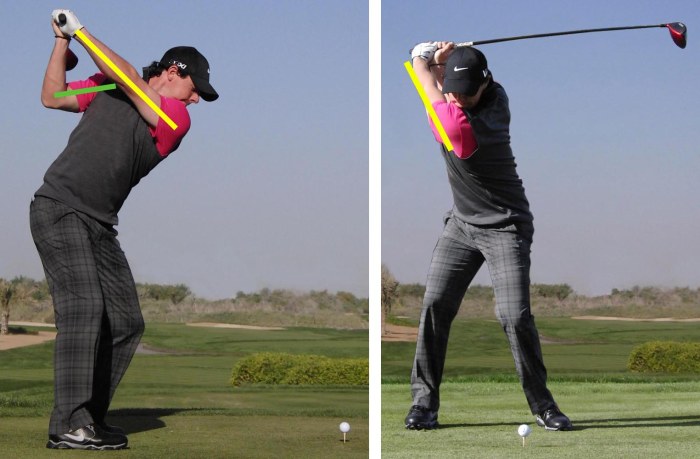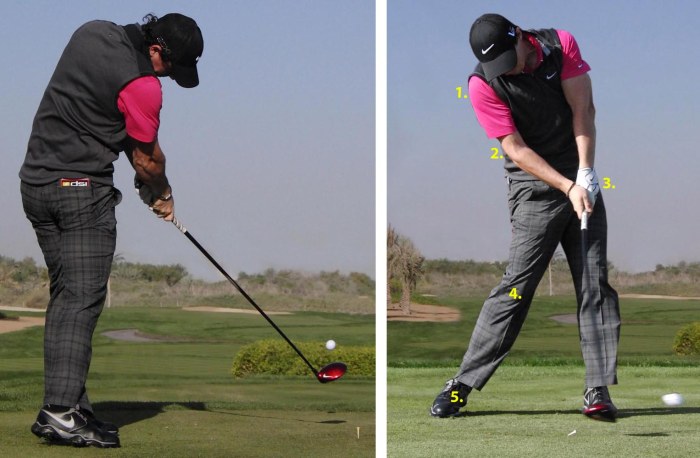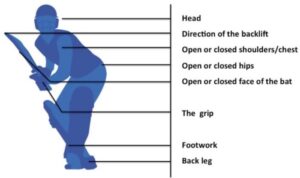Get ready to step up your golf game with these top-notch golf swing tips that will take your skills to the next level. From mastering the basics to fine-tuning your mechanics, this guide has got you covered.
Whether you’re a beginner looking to improve your swing or a seasoned pro aiming for perfection, these tips will help you achieve your golfing goals with style.
Golf Swing Fundamentals
To excel in golf, mastering the fundamentals of the golf swing is crucial. A proper golf swing is the foundation of a successful game, and understanding its key components is essential for improvement.
Basic Principles of a Golf Swing
- Alignment: Positioning your body correctly in relation to the target.
- Grip: Holding the club in the correct manner for control and power.
- Stance: Setting up your body in the proper position for balance and coordination.
Key Components of a Proper Golf Swing
- Backswing: Rotating your body and club away from the target to generate power.
- Downswing: Transitioning your weight and club towards the target for impact.
- Follow-through: Completing the swing with a smooth motion for accuracy and distance.
Importance of Balance and Posture
Maintaining balance throughout the swing is crucial for consistency and power. Proper posture ensures that your body is in the optimal position to generate speed and control the club. By focusing on balance and posture, you can enhance the quality of your golf swing and improve your overall performance on the course.
Grip and Stance Techniques

When it comes to mastering the art of the golf swing, having the right grip and stance is essential for achieving optimal performance on the course. Let’s dive into the different techniques that can help improve your game.
Types of Grips
- The overlapping grip, also known as the Vardon grip, is a popular choice where the pinky of the trailing hand rests on top of the index finger of the lead hand.
- The interlocking grip involves interlocking the pinky finger of the trailing hand with the index finger of the lead hand, providing a secure connection.
- The baseball grip, also called the ten finger grip, is when all ten fingers are on the club, offering more control but less power.
Optimal Stance and Alignment
- For a solid stance, position your feet shoulder-width apart, with your weight evenly distributed between both feet.
- Align your body parallel to the target line, ensuring your shoulders, hips, and feet are all pointing in the same direction.
- Keep a slight bend in your knees and tilt your spine forward to promote a natural swing motion.
Variations in Grip and Stance for Different Clubs
- When using a driver, a slightly wider stance and a more neutral grip can help generate more power and distance.
- For shorter clubs like wedges, a narrower stance and a firmer grip may provide better control and accuracy for precise shots.
- Experiment with different grip and stance combinations to find what works best for each club in your bag.
Swing Mechanics: Golf Swing Tips

To achieve a powerful and effective golf swing, it is crucial to understand the sequence of movements involved, how to generate power and speed, as well as common mistakes to avoid.
Sequence of Movements
- Address Position: Start with a proper stance, feet shoulder-width apart, and the club head behind the ball.
- Backswing: Rotate your torso and shoulders away from the target while keeping your arms extended.
- Top of the Swing: When your club reaches the highest point, your wrists should be fully cocked.
- Downswing: Begin the downswing by rotating your hips towards the target and shifting your weight onto your front foot.
- Impact: The moment of truth where the club strikes the ball, with your hips open and hands leading the club head.
- Follow Through: Continue the swing after impact, allowing your body to rotate fully and the club to finish high over your shoulder.
Generating Power and Speed
- Proper Rotation: Utilize your body’s rotation to generate power, rather than relying solely on arm strength.
- Leverage: Maintain a straight leading arm through impact to maximize the club’s speed and power transfer.
- Weight Transfer: Shift your weight from back foot to front foot during the downswing to create more power and speed.
- Timing: Ensure a smooth transition from backswing to downswing for optimal power generation.
Common Mistakes and Corrections
- Over-swinging: Avoid taking the club too far back, as it can lead to loss of control and power. Focus on a compact and controlled swing.
- Casting: Prevent early release of the club by maintaining wrist hinge until impact, allowing for maximum power transfer.
- Lack of Rotation: Insufficient body rotation can limit power generation. Work on rotating your hips and shoulders fully for a powerful swing.
- Improper Weight Shift: Failing to transfer weight properly can result in weak and inconsistent shots. Practice shifting weight smoothly for added power.
Drills and Exercises
To improve your golf swing consistency, it’s essential to practice drills and exercises that target specific areas of your swing mechanics. By incorporating these into your routine, you can enhance your flexibility, strength, and overall performance on the course.
Drill 1: Alignment Drill
One effective drill to improve swing consistency is the alignment drill. Place a club on the ground parallel to your target line and practice hitting shots while ensuring your clubface aligns with the target. This helps develop proper alignment and aim, leading to more accurate shots.
Drill 2: Tempo Drill
Another important aspect of a consistent swing is maintaining proper tempo throughout. To practice this, focus on swinging smoothly and rhythmically without rushing your backswing or downswing. Use a metronome or count in your head to keep a steady tempo and improve your timing.
Exercise: Rotational Exercises, Golf swing tips
Enhancing flexibility and strength in your core muscles is crucial for a powerful and consistent swing. Incorporate rotational exercises such as Russian twists, medicine ball wood chops, and torso rotations to improve your ability to rotate your body during the swing. This will help generate more power and maintain balance throughout the motion.
Exercise: Golf-specific Strength Training
Engaging in golf-specific strength training exercises can target muscles used in the golf swing, such as the glutes, core, and shoulders. Include exercises like squats, lunges, planks, and shoulder presses to build strength and stability, leading to a more controlled and powerful swing.
Effective Practice Tips
To ingrain good swing habits, it’s essential to practice effectively. Focus on quality over quantity by incorporating deliberate practice sessions that address specific aspects of your swing. Utilize video analysis, feedback from a coach, and mental visualization techniques to identify areas for improvement and make necessary adjustments.

